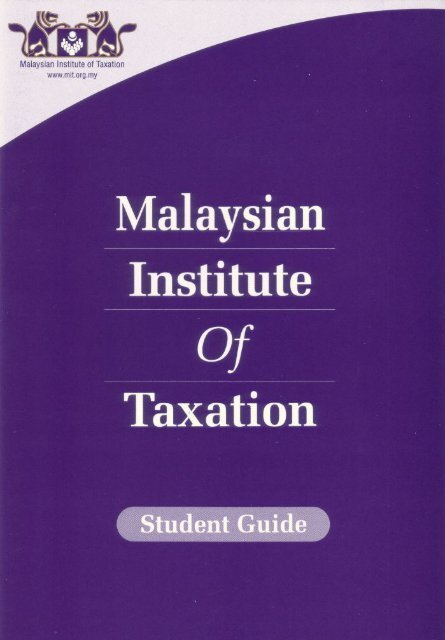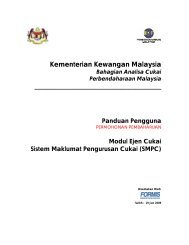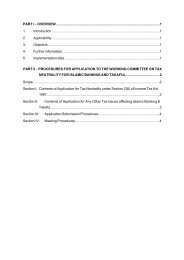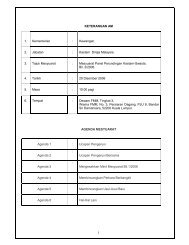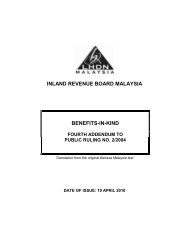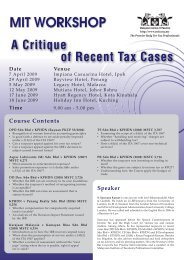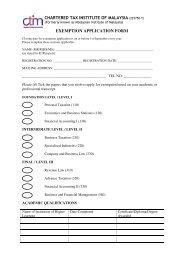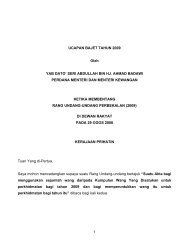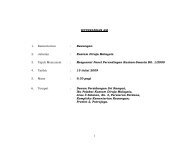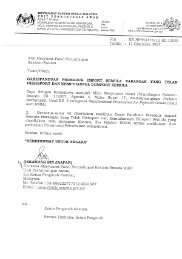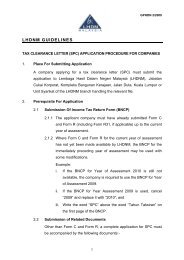Untitled - Chartered Tax Institute of Malaysia
Untitled - Chartered Tax Institute of Malaysia
Untitled - Chartered Tax Institute of Malaysia
Create successful ePaper yourself
Turn your PDF publications into a flip-book with our unique Google optimized e-Paper software.
CONTENTSi. FOREWORDii.LIBRARY FACILITIESiii.TAXATION AS A CAREERiv.ENTRANCE REQUIREMENTS AND EXEMPTIONSv. EXAMINATION SYLLABUSvi.READING GUIDEvii.APPENDICESAppendix 1 Qualifications deemed equivalent to HSC/STPMrequirementAppendix 2 Qualifications deemed to supersede the minimumentry requirementAppendix 3 List <strong>of</strong> overseas accountancy bodies recognised forexemptionAppendix 4 List <strong>of</strong> recognised local institution <strong>of</strong> higher learningand pr<strong>of</strong>essional bodiesAppendix 5 Examination Regulations2
FOREWORDThis guide provides information for students, their employers, career advisersand teachers. It contains general information about the <strong>Institute</strong> as well as details<strong>of</strong> how to qualify as a member.Registered students should keep their guide and refer to it on all mattersconcerning their preparation for membership. Notification <strong>of</strong> any changes inrequirements or arrangements will be given in the <strong>Institute</strong>'s quarterly journal.The <strong>Institute</strong>'s <strong>of</strong>fice is open from 8.45 am to 5.00 pm on Monday to Friday and8.45 am to 12.45 pm on Saturday.LIBRARY FACILITIESAccessThe library is open to members and registered students <strong>of</strong> <strong>Malaysia</strong>n <strong>Institute</strong> <strong>of</strong><strong>Tax</strong>ation.Library HoursMonday - FridaySaturday8:45 am - 5:00 pm8:45 am - 12:45 pmThe library is situated at the following address:Dewan AkauntanNo. 2 & 4, Level 2Jalan Tun Sambanthan 3Brickfields50470 Kuala Lumpur.3
TAXATION AS A CAREERCongratulations for your interest in taxation. Knowledge in taxation can providethe quantum leap and added value in whatever you do, either in the field <strong>of</strong>management, accounting, law, medicine or even as a tax agent. As the sayinggoes, there is nothing in this world as certain as death and tax. This clearlydemonstrates the importance <strong>of</strong> taxation in everyone's life.The <strong>Malaysia</strong>n <strong>Institute</strong> <strong>of</strong> taxation (MIT) is the ONLY pr<strong>of</strong>essional body in<strong>Malaysia</strong> to provide an entry level to the world <strong>of</strong> taxation. It's objective is totrain and build up a pool <strong>of</strong> qualified taxation personnel as well as to foster andmaintain the highest standard <strong>of</strong> pr<strong>of</strong>essional ethics and competency among itsmembers.<strong>Tax</strong> is not just the application <strong>of</strong> simple rules. One has to be well versed in thelegislation, have the ability to research into case law, keep in touch with theadministrative/tech nical practices o f th e tax autho rities, b e ab le to exp ressthoughts and opinions in writing as well as exhibit diplomacy and tact in order toget the right results. It is in other words, an exciting pr<strong>of</strong>ession.Practical training in the field <strong>of</strong> taxation will develop individuals to be planners,strategists and decision makers. <strong>Tax</strong> pr<strong>of</strong>essionals are in demand because allorganisations - whether small, medium or large conglomerates require taxationadvice, whether in compliance work such as furnishing tax computations or in anadvisory capacity in tax planning work. Other functions <strong>of</strong> a tax pr<strong>of</strong>essional are:(i)Advising on structuring <strong>of</strong> executive remuneration packages;(ii) Advising on types <strong>of</strong> investment incentives provided by the government;(iii) Advising on restructuring and reorganisation schemes which may involvetransfers <strong>of</strong> shares, real property, trading stock, fixed assets, debtors, etc.;(iv) Advising both local and foreign investors on the type <strong>of</strong> business structuresthat may be more tax efficient;(v)Cross border tax planning.<strong>Tax</strong> pr<strong>of</strong>essionals are mobile. The tax job is interesting, well paid, and one canfind employment in public accounting firms, the commercial sector or even theInland Revenue Board.You should have no doubt if you choose to embark in the field <strong>of</strong> taxation withMIT. The designation <strong>of</strong> an Associate <strong>of</strong> <strong>Tax</strong>ation <strong>Institute</strong> Incorporated (ATII)denotes the candidate with the competitive edge.4
ENTRANCE REQUIREMENTS AND EXEMPTIONS1.0 <strong>Malaysia</strong>n <strong>Institute</strong> <strong>of</strong> <strong>Tax</strong>ation's Pr<strong>of</strong>essional Examination1.1 The MIT Examination is held annually and comprises 3 parts or levels asoutlined on page 8. The specific subjects that a student is required to writein order to qualify for membership <strong>of</strong> the <strong>Institute</strong> depend on his educationalbackground described in Section 2.0.1.2 Any registered student who has passed the examinations prescribed (unlessthe Council shall have granted exemptions from such examinations or partsthere<strong>of</strong>) and who has had not less than five (5) years practical experience inpractice or employment relating to taxation matters approved by the Councilwould be eligible to be admitted as an Associate <strong>of</strong> the <strong>Institute</strong>.1.3 A pass would be given for a paper passed at each part or level. The studentis however required to complete an earlier part or level <strong>of</strong> the examinationsbefore proceeding to the next part or level.2.0 Entrance Qualifications2.1 The <strong>Institute</strong> admits students with various educational backgrounds.(a)Normal Studento Has attained the age <strong>of</strong> seventeen (17)ooHas obtained principal level passes in at least two subjects( e x c l u d i n g K e r t a s A m / P e n g a j i a n A m ) o f t h e H S C / S T P MexaminationHas obtained a MCE / SPM with credits in English Language andMathematics and an ordinary pass in Bahasa <strong>Malaysia</strong>. (TheG.C.E. is deemed to be equivalent if an ordinary pass in theBahasa <strong>Malaysia</strong> paper <strong>of</strong> the MCE/SPM examination is obtainedat a supplementary sitting)A list <strong>of</strong> other qualifications which have been recognised by theCouncil as equivalent to the HSC/STPM requirement is listed inAppendix 1.(b)Degrees, Diplomas and Pr<strong>of</strong>essional QualificationsA range <strong>of</strong> degrees, diplomas and pr<strong>of</strong>essional qualifications fromboth local and overseas institutions have been recognised by the5
<strong>Institute</strong> to supersede the minimum requirements specified in (a)above. Holders <strong>of</strong> such qualifications may be eligible for exemptionfr o m c e r t a in r el e v a n t p ap e r (s) d ep en d in g o n th e ir e d u c at ion a lbackgrounds. (Refer Appendix 2 for List <strong>of</strong> Qualifications Deemed toSupersede the Minimum Entry Requirements)(c)Full Members <strong>of</strong> Overseas Accountancy BodiesApplicants who are not members <strong>of</strong> <strong>Malaysia</strong>n <strong>Institute</strong> <strong>of</strong> Accountantsand who are full members <strong>of</strong> overseas accountancy bodies which arerecognised by the <strong>Institute</strong> are only required to sit for the Company &Business Law and <strong>Tax</strong>ation papers (ie : <strong>Tax</strong>ation I, II, III, IV and V)<strong>of</strong> the MIT examination. (Refer Appendix 3 for List <strong>of</strong> OverseasAccountancy bodies recognised).However, full members <strong>of</strong> overseas accountancy bodies who haveacquired adequate working knowledge <strong>of</strong> <strong>Malaysia</strong>n Company andBusiness Law and <strong>Tax</strong>ation Law may apply for exemption from sittingthe papers provided they fulfill the following conditions:-(i) The applicant must be a full member <strong>of</strong> an accountancy bodyrecognised by the <strong>Institute</strong>.(ii) The applicant must have obtained at least five years approvedaccountancy and taxation experience in <strong>Malaysia</strong>.(iii) The applicant must satisfy the Council as to knowledge <strong>of</strong><strong>Malaysia</strong>n Company & Business Law and <strong>Tax</strong>ation Law.(c)Other QualificationsApplicants who are not members <strong>of</strong> Malay sian <strong>Institute</strong> <strong>of</strong> Accountantsand who possess any <strong>of</strong> the qualifications listed below will be eligiblefor exemption at the discretion <strong>of</strong> the Council:oooGraduate/Member <strong>of</strong> the <strong>Malaysia</strong>n <strong>Institute</strong> <strong>of</strong> Certified PublicAccountants (MICPA)Graduate/member <strong>of</strong> the <strong>Chartered</strong> <strong>Institute</strong> <strong>of</strong> ManagementAccountants (UK)Recognised Degrees in Accounting and Advanced Diploma inAccountancy from local institutions <strong>of</strong> higher learning (ReferAppendix 4 for list <strong>of</strong> recognised local institution <strong>of</strong> higher learning)6
3.0 ExemptionsExemptions from specific papers in the MIT Examination are available toholders <strong>of</strong> relevant university degrees, diplomas and other pr<strong>of</strong>essionalqualifications. The extent <strong>of</strong> exemption granted will depend on the level <strong>of</strong>the qualification attained and the relevance <strong>of</strong> course content as determinedby the Council.Holders <strong>of</strong> non-relevant degrees/diplomas from local and overseas intitutions<strong>of</strong> higher learning are eligible for subject exemption on the basis that theparticular subject for which exemption is sought has been covered in thedegree/diploma programme for at least two semesters or one academic year.All applications for exemption or evaluation <strong>of</strong> qualification for possibleexemption must be made in prescribed forms available from the MIT <strong>of</strong>ficeat the time <strong>of</strong> registration as a student. No further exemptions will be grantedthere after. Appropriate fees must be paid immediately upon receipt <strong>of</strong> theExemption Invoice.4.0 Members <strong>of</strong> the <strong>Malaysia</strong>n <strong>Institute</strong> <strong>of</strong> AccountantsAny person who is registered with <strong>Malaysia</strong>n <strong>Institute</strong> <strong>of</strong> Accountants as a<strong>Chartered</strong> Accountant is eligible to apply for membership to the <strong>Institute</strong>without having to sit for the MIT Examination subject to the followingrequirements.(a) Any person who is registered with MIA as a <strong>Chartered</strong> Accountant andwho holds a Practising Certificate and an audit licence issued pursuantto the Section 8 <strong>of</strong> the Companies Act, 1965.(b) Any person who is registered with MIA as a <strong>Chartered</strong> Accountantwith Practising Certificate only and has had not less than two (2) yearspractical experience in practice or employment relating to taxationmatters approved by the Council.(c) Any person who is registered with MIA as a <strong>Chartered</strong> Accountantwithout Practising Certificate and has had not less than three (3) yearspractical experience in practice or employment relating to taxationmatters approved by the council.(d) Any person who is registered with MIA as a Licensed Accountant andwho has had not less than five (5) years practical experience in practicerelating to taxation matters approved by the council after admission asa licensed accountant <strong>of</strong> the MIA under the Accountants Act, 1967.7
EXAMINATION SYLLABUSFOUNDATION LEVELEconomics and Business Statistics<strong>Tax</strong>ation IFinancial Accounting IINTERMEDIATE LEVEL<strong>Tax</strong>ation II<strong>Tax</strong>ation IIICompany and Business LawFINAL LEVEL<strong>Tax</strong>ation IV<strong>Tax</strong>ation VFinancial Accounting IIBusiness and Financial ManagementExemption fess (per paper)Foundation RM50Intermediate RM60Final RM70Examination fees (per paper)Foundation RM50Intermediate RM60FinalRM708
FOUNDATION LEVELECONOMICS AND BUSINESS STATISTICS(a)ECONOMICSObjective:To examine the basic concepts <strong>of</strong> microeconomics, macroeconomics andpublic finance and their applications.Contents:(1) Introduction to Economics- The Scope .and Method <strong>of</strong> Economics- The Economic Problem: Scarcity, Choice and Opportunity Cost- Economic Systems(2) Household Behaviour and Consumer Choice- The Production Process: The Behaviour <strong>of</strong> Pr<strong>of</strong>it-Maximizing Firms- Demand, Supply and Market Equilibrium- The Price System, Supply and Demand and Elasticity- Short-Run Costs and Output Decisions- Costs and Output Decisions in the Long Run- Input Demand: The Labour and Land Markets- Input Demand: The Capital Market and the Investment Decision- Market structures: Determination <strong>of</strong> price and output in perfectcompetition vs Imperfect competition market (monopoly,monopolistic competition and oligopoly)- Externalities, Public Goods, Imperfect Information and Social Choice(3) Macroeconomics- Measuring national output and national income: including GDP,GNP and net income, nominal vs real and price index- Keynesian theory: aggregate demand and aggregate supply,aggregate expenditure and equilibrium output, including income,consumption, saving, investment and the multiplier concept- The money demand and money supply, Equilibrium interest rate andFederal Reserve System- Macroeconomics concerns: Monetary policy and fiscal policy- Debates in Macroeconomics: Keynesian, Monetarism, New ClassicalTheory and supply side economics
- Open economy macroeconomics: International trade, comparativead vantage, abso lute ad vantage and p rotection ism, th e balance<strong>of</strong> payments and exchange rate(b) BUSINESS STATISTICSObjective:To examine the basic concepts <strong>of</strong> quantitative techniques and analyticalskills that are relevant to economics, business and accounting.Contents:(1) Statistical presentationApplication <strong>of</strong> techniques in the collection and description <strong>of</strong> numericalbusiness data.- Types <strong>of</strong> information and their uses: qualitative and quantitative;discrete and continuous data- Primary and secondary data: collection <strong>of</strong> data and sampling methods- Tabulation and grouping <strong>of</strong> data: frequency distribution, relativefrequency distribution, percentage distribution, cumulativedistribution- Graphical representation: histogram, pie charts, ogive, polygons,bar charts(2) Statistical measuresI n c l u d e s t e c h n i q u e s fo r s u m m a r i z i n g l a r g e d a t a s e t s c o m mo n l yoccurring within many business functions.- Measures <strong>of</strong> centrality: mean, median and mode; group andungrouped data- Measures <strong>of</strong> dispersion: standard deviation, coefficient <strong>of</strong> variation,range, quartile deviations- Statistical inference: confidence intervals and hypothesis testingfor mean and proportion for a single population(3) Measurement <strong>of</strong> uncertaintyTo apply the measurement <strong>of</strong> uncertainty with regard to investmentdecisions, auditing, budgeting and other areas <strong>of</strong> business.- Normal distribution- Central Limit Theorem10
TAXATION I- Probability: addition and multiplication rules, tree diagrams, Bayes'theorem, decision analysis, expected value <strong>of</strong> perfect information- Simple Regression and Correlation Analysis- Business Forecasting and Time SeriesObjective:To examine the basic concepts (including reference to case law) <strong>of</strong> <strong>Malaysia</strong>nincome tax and its application to individuals as well as ethical practice.Contents:- Scope and Basis- taxation as a source <strong>of</strong> government revenue- understanding <strong>of</strong> general system <strong>of</strong> taxation in <strong>Malaysia</strong>- scope <strong>of</strong> charge- classes <strong>of</strong> income chargeable to tax- exemptions- chargeable persons- tax rates- Residence <strong>of</strong> Individuals- determination <strong>of</strong> residence status- significance <strong>of</strong> residence status- Sources <strong>of</strong> IncomeEmployment- meaning <strong>of</strong> employment- distinction between contract <strong>of</strong> service and contract for services- gains or pr<strong>of</strong>its from employment- basis <strong>of</strong> assessment- valuation <strong>of</strong> benefits-in-kind- deductible expenses- compensation for loss <strong>of</strong> <strong>of</strong>fice- gratuities- share options, incentive schemes and pr<strong>of</strong>it sharing schemes- exemptions- Other Sources- dividends11
- interest- discounts- rents- royalties- premiums- pensions- periodical payments- annuities- other gains or pr<strong>of</strong>its- occupation <strong>of</strong> premises for non-business purposes- basis <strong>of</strong> assessment- deductible expenses- exemptions- Personal Reliefs and Rebates- Computation <strong>of</strong> <strong>Tax</strong> Liability- taxation <strong>of</strong> husband and wife- determination <strong>of</strong> chargeable income- computation <strong>of</strong> tax payable- <strong>Tax</strong> Administration- organizational structure <strong>of</strong> the Ministry <strong>of</strong> Finance, Inland RevenueBoard and the Royal Customs & Excise Department- duties and powers <strong>of</strong> the Director General <strong>of</strong> Inland Revenue- returns- assessments- collection and recovery- appeals- <strong>of</strong>fences and penalties- Pr<strong>of</strong>essional EthicsThis will include the following:- form <strong>of</strong> practice and matters relating thereto- obligations to clients and confidentiality- matters relating to the affairs <strong>of</strong> new clients- handling client work and all matters relating thereto- charging for services- matters giving rise to conflict <strong>of</strong> interest- disclosures in tax returns, computations and correspondence with theInland Revenue12
- dealing with Inland Revenue errors in favour <strong>of</strong> taxpayers, tax evasion,tax avoidance and ethical/moral issuesFINANCIAL ACCOUNTING IObjective:To examine the understanding <strong>of</strong> the nature, principles and scope <strong>of</strong> financialaccounting and the applications and implications <strong>of</strong> accounting concepts andconventions.Contents:- The Basic Structure <strong>of</strong> Accounting- The accounting pr<strong>of</strong>ession- Types <strong>of</strong> business organisations- The structure <strong>of</strong> <strong>Malaysia</strong>n accounting standards setting- Accounting concepts and principles- The accounting equation- Recording, handling and summarising accounting data(including cash book, bank reconciliation statement, petty cash book,sales and purchase books, return inward and outward books, generaljournal, double entry accounting system, general ledger, trial balance,control accounts, correction <strong>of</strong> errors and preparation <strong>of</strong> suspenseaccount)- Measuring business pr<strong>of</strong>it: The adjusting process (accruals, prepayments,income in arrear and in advance) and adjusted trial balance- The framework <strong>of</strong> accounting- The conceptual framework- Objective <strong>of</strong> financial reporting- Underlying assumptions- Accounting principles- Constraints on accounting- True and fair view- Introduction to Accounting systems- Accounting systems design- Computer data processing- Effective systems <strong>of</strong> internal control- Computer and internal control13
- Accounting treatment <strong>of</strong>- cash and bank- accounts receivable- inventory- non-current assets and intangible assets- revaluation <strong>of</strong> non-current assets- current liabilities- contingent liabilities- post-balance sheet events- Preparation <strong>of</strong> financial statements for(a)(b)Sole traders from simple incomplete recordsClubs and societies- receipts and payments accounts- income and expenditure accounts(c) Partnerships- Characteristics <strong>of</strong> a partnership- Initial investment by partners- Sharing partnership pr<strong>of</strong>its and losses- Drawings- Treatment <strong>of</strong> goodwill- Dissolution <strong>of</strong> a partnership- Withdrawal <strong>of</strong> a partner- Death <strong>of</strong> a partner(d) Manufacturing companies - manufacturing accounts- Interpretation and analysis <strong>of</strong> financial statements- Preparation <strong>of</strong> significant ratios and using the ratios to appraise theperformance and future prospects <strong>of</strong> a businessNote: Students are expected to be familiar with the approved accountingstandards and pronouncements in <strong>Malaysia</strong> issued by MASB andalso with local legislation and reporting requirements governing thepreparation <strong>of</strong> accounts and financial statements.14
INTERMEDIATE LEVELTAXATION IIObjective:To examine the principles (including reference to case law) and application <strong>of</strong><strong>Malaysia</strong>n income tax on businesses.Contents:- Business Source- definition <strong>of</strong> business- badges <strong>of</strong> trade- commencement and cessation <strong>of</strong> business- basis <strong>of</strong> assessment including change <strong>of</strong> accounting date- capital and revenue receipts- deductibility <strong>of</strong> expenses- Deductions for Capital Expenditure- meaning <strong>of</strong> plant and machinery, as well as industrial building- determination <strong>of</strong> initial allowance, annual allowance, balancingallowance and balancing charge in respect <strong>of</strong> plant and machinery andindustrial buildings- agriculture, forest and mining allowances- expenditure on prospecting operations- expenditure on approved agricultural projects- disposals subject to control- Partnerships- existence <strong>of</strong> a partnership- ascertainment <strong>of</strong> provisional adjusted income/loss as well as divisibleincome/loss- changes in partners- Corporate <strong>Tax</strong>ation- determination <strong>of</strong> residence status- significance <strong>of</strong> residence status- basis periods and change <strong>of</strong> accounting date- section 108 computation15
- Computation <strong>of</strong> <strong>Tax</strong> Liability- treatment <strong>of</strong> losses- determination <strong>of</strong> chargeable income- computation <strong>of</strong> tax payable- Avoidance <strong>of</strong> Double <strong>Tax</strong>ation- double taxation agreements- non-resident relief- unilateral relief and bilateral relief- <strong>Tax</strong>ation <strong>of</strong> Non-Residents- withholding taxes- non-resident reliefTAXATION IIIObjective:To examine the application <strong>of</strong> advanced aspects <strong>of</strong> <strong>Malaysia</strong>n taxation, includingreal property gains tax and indirect taxes.Contents:- Specialized activities- leasing- co-operative societies- trade associations and clubs- charitable institutions- trust bodies, settlements and estates under administration- petroleum, banking, insurance, sea and air transport undertakings- unit trusts- property developers- investment holding companies- Cross Border Transactions- distinction between trading in and trading with <strong>Malaysia</strong>- double taxation agreements (with emphasis on determination <strong>of</strong> apermanent establishment, business pr<strong>of</strong>its, personal services and taxsparing relief)16
- Real Property Gains <strong>Tax</strong>- principles and scope <strong>of</strong> charge- chargeable assets and persons- exemptions- computation <strong>of</strong> chargeable gains and allowable losses- tax rates- returns and assessments- payment and recovery <strong>of</strong> tax- Indirect <strong>Tax</strong>es (including stamp duty)- role and powers <strong>of</strong> the Royal Customs & Excise Department- import duty- export duty- excise duty- sales tax- service tax- stamp dutyCOMPANY AND BUSINESS LAWObjective:To examine understanding <strong>of</strong> the laws relating to limited companies, soleproprietorships,partnerships and other business organizations.Contents:(a)COMPANY LAW- Types <strong>of</strong> companies and corporate personality- Formation and registration procedures- Powers <strong>of</strong> a company and its memorandum and articles <strong>of</strong> association- Types <strong>of</strong> statutory records- Dividends and classes <strong>of</strong> shares- Loans to directors and shareholders- Duties, powers, rights and liabilities <strong>of</strong> directors- Code <strong>of</strong> ethics for directors- Appointment, removal and remuneration <strong>of</strong> directors- Annual general meetings and other meetings- Conduct <strong>of</strong> meetings- Company secretaries - duties and liabilities- Reconstructions, mergers and take-overs- Liquidation and dissolution17
(b) BUSINESS LAW- Laws relating to sole-proprietors and partnerships including law <strong>of</strong>agency- Law <strong>of</strong> Contract- Negotiable instruments - Bills <strong>of</strong> Exchange Act- Laws relating to sale <strong>of</strong> goods, hire purchase and leasing- Formation procedures <strong>of</strong> business organizations (other than limitedcompanies)- Bankruptcy lawFINAL LEVELTAXATION IVObjective:To examine understanding <strong>of</strong> the interpretation <strong>of</strong> income tax statutes throughcase law decisions.Contents:- Rules <strong>of</strong> Interpretation <strong>of</strong> tax statutes/legislation- The Basis <strong>of</strong> <strong>Malaysia</strong>n <strong>Tax</strong>ation(i) The derived income basis,(ii) The remittance basis,(iii) Classes <strong>of</strong> Income.- Employment Income(i)(ii)(iii)(iv)(v)(vi)Residence <strong>of</strong> individuals.Pr<strong>of</strong>ession or employment.Meaning <strong>of</strong> having or exercising an employment.Gross income from employmentDerivation <strong>of</strong> employment incomeExemptions- Business Income & Losses(i) Trading and adventure in the nature <strong>of</strong> trade :(a) Meaning <strong>of</strong> adventure or concern in the nature <strong>of</strong> trade(b) Badges <strong>of</strong> trade(c) Mutual trading(d) Illegal activitie18
(ii)(iii)Commencement/Cessation <strong>of</strong> BusinessCapital and Revenue Receipts- Partnerships- Capital and Revenue Expenditure- Relief for Capital Expenditure(including controlled transfer provisions)- Companies and bodies <strong>of</strong> persons(i) Residence status and its significance(ii) The Imputation system- D i v i d e n d s , I n t e r e s t , R o y a l t i e s , A n n u i t i e s , R e n t s , P r e m i u m s ,Discounts, Periodical Gains and Other Gains or Pr<strong>of</strong>its.- Real Property Gains <strong>Tax</strong>- Double <strong>Tax</strong>ation AgreementsTAXATION VObjective:To e x a min e th e abili t y to p ro vid e a co mp r eh en si v e and p r a ct ical r esp o n s et o specific problems.Contents:(Questions may involve more than one type <strong>of</strong> tax and the paper as a whole willcontain questions requiring knowledge <strong>of</strong> all <strong>of</strong> the areas and taxes covered in<strong>Tax</strong>ation I to <strong>Tax</strong>ation IV.Questions may also require a knowledge <strong>of</strong> other aspects <strong>of</strong> law and accountancythat a tax practitioner may encounter.Questions may require reports, letters or computations.)- <strong>Tax</strong> Incentives- <strong>Tax</strong> PlanningThis will include the following:- identifying opportunities to alleviate, mitigate or defer the impact <strong>of</strong>direct or indirect taxation19
- anti-avoidance provisions- pricing policy- uses <strong>of</strong> tax incentives- <strong>Tax</strong> Investigations- powers <strong>of</strong> the Director General <strong>of</strong> Inland Revenue- events which may trigger an investigation- methods <strong>of</strong> computing omitted/understated income- capital statements- negotiation for settlement- Pr<strong>of</strong>essional ethics- <strong>Tax</strong> Policies- types <strong>of</strong> tax systems- role <strong>of</strong> taxation in economic development- design <strong>of</strong> tax policy criteria for evaluation <strong>of</strong> a tax system- tax reforms- awareness <strong>of</strong> recent developments in the field <strong>of</strong> taxation (e.g. selfassessment,value added tax, etc.)FINANCIAL ACCOUNTING IIObjective:To examine the financial accounting concepts and principles, including therelevant statutory requirements and compliance with the approved accountingstandards in <strong>Malaysia</strong> issued by the <strong>Malaysia</strong>n Accounting Standards Board(MASB).Contents:- Sole trader and partnership conversions to a limited liability company- accounting treatment for the conversion <strong>of</strong> a sole trader into a limitedcompany- accounting treatment for the conversion <strong>of</strong> a partnership into a limitedcompany- Characteristics <strong>of</strong> a company- Company Formation, Prospectus and Published Accounts20
- formation <strong>of</strong> companies; prospectus; accounting treatment for classes<strong>of</strong> shares; issue <strong>of</strong> shares; bonus and rights issues; reserves; retainedpr<strong>of</strong>its, dividends and taxation; share splits; share buybacks; earningsper share; types <strong>of</strong> debentures; issue and redemption <strong>of</strong> debentures; andcompliance with legal requirements- preparation and presentation <strong>of</strong> financial statements (for publication inaccordance with the Company's Act 1965)- director's report and auditor's report- Company Reconstruction- rationale- internal reconstruction/capital reduction- external reconstruction/capital reduction- books <strong>of</strong> the new company- books <strong>of</strong> the old company- Joint ventures- understanding the nature <strong>of</strong> a joint venture- accounting treatment for a simple joint venture- Branch accounts (excluding foreign branch)- preparation <strong>of</strong> separate and combined financial statements for head<strong>of</strong>fice and branch- Analysing and evaluation <strong>of</strong> financial statements- preparing cash flow statement (MASB 5)- calculating significant ratios to appraise and communicate the positionand prospects <strong>of</strong> a business- recognising the working capital requirements <strong>of</strong> a business- Group accounts- definition <strong>of</strong> holding company, subsidiary and associated company- preparing consolidated balance sheet, pr<strong>of</strong>it and loss account and cashflow statement for a holding company with one subsidiary and/or oneassociated company- MASB 11: Consolidated Financial Statementsand Investments inSubsidiaries- MASB 12: Investments in Associates21
Note:Stud ents are expected to be familiar with the app ro ved accoun tin gstandards and pronouncements in <strong>Malaysia</strong> issued by MASB and alsow i t h l o c a l l e g i s l a t i o n a n d r e p o r t i n g r e q u i r e m e n t s g o v e r n i n g t h epreparation <strong>of</strong> accounts and financial statements.BUSINESS & FINANCIAL MANAGEMENTObjective:To examine knowledge <strong>of</strong> principles and issues in business and financial management.Contents:(1) Business ManagementTopics covered include:- Principles <strong>of</strong> management and control; formulation <strong>of</strong> policy; delegation<strong>of</strong> authority and responsibility; organizational structure and socialresponsibility <strong>of</strong> management.- D e v e l o p m e n t o f i n t e g r a t i v e p r o g r a m s o f a c t i o n t h a t r e fl e c torganization's environmental, financial, people and time.- Principles <strong>of</strong> human resource management; selection, education andtraining, promotion; human relations; safety; welfare includingEmployment Act.- Marketing and sales management;product, pricing, promotion anddistribution channels.- Communication channels, information technology and report writing.(2) Financial ManagementTopics covered include :- Financial mathematics : simple and compound interest, nominal andeffective interest rates, annuities, perpetuities, discounted cash flow;net present value, internal rate <strong>of</strong> return.- The <strong>Malaysia</strong>n Financial System.- flow <strong>of</strong> funds in an economy- Bank Negara <strong>Malaysia</strong>- major financial institutions- non-banking financial intermediaries- Islamic banking- Kuala Lumpur Stock Exchange22
- Financial Futures and Option Exchange (KLOFFE)- money and foreign exchange- Essential concepts in financial management.- time value <strong>of</strong> money- an introduction to risk-return trade-<strong>of</strong>f- Tools <strong>of</strong> financial analysis, planning and decision making.- financial ratio analysis- funds and cash flow analysis- financial forecasting- financial planning and control- Working capital management.- Capital structure and cost <strong>of</strong> capital; capital gearing, dividend policy.(3) <strong>Malaysia</strong>n Government Policies and Regulations.Students are required to know various <strong>Malaysia</strong>n government policiesand regulations that affect business and finance.- Role and Functions <strong>of</strong>:-- Ministry <strong>of</strong> International Trade and Industry- <strong>Malaysia</strong>n Industrial Development Authority- Foreign Investment Committee Guidelines- Registrar <strong>of</strong> Companies- Rating Agencies- Industrial Coordination Act including procedures <strong>of</strong> obtaining manufacturinglicences and investment incentives.- Wholesale and Retail Trade Guidelines- Foreign Exchange Control Guidelines23
READING GUIDE]ECONOMICS AND BUSINESS STATISTICSECONOMICS1. * Case and Fair. Principles <strong>of</strong> Economics. 6th Edition. Prentice Hall, 2003.2. Irvin B. Tucker. Economics for Today. 2nd Edition. South WesternCollege. Thomson Learning, 1999.3. Begg. D. Economics. 5th Edition. McGraw Hill, 1997.4. McConnel, Brue. Economics. Principles. Problems and Policies. 14thEdition. McGraw Hill, 1998.5. Ministry <strong>of</strong> Finance. Laporan Ekonomi/Economic Report.6. Bank Negara <strong>Malaysia</strong>. Laporan Tahunan/Annual Report.BUSINESS STATISTICS1.* Berenson, M. L., Levine, D. M. and Krehbiel, T.C. Basic BusinessStatistics: Concepts and Applications. 8th Edition. Prentice Hall, 2003.2. Barrow M. Statistics for Economics. Accounting and Business Studies.2nd Edition. Addison Wesley Longman <strong>Malaysia</strong>, 1996.3. Gregory, D. and Ward, H. Statistics for Business Studies. 4th Edition.London: McGraw Hill, 1993.TAXATION I1. * Veerinderjeet Singh. <strong>Malaysia</strong>n <strong>Tax</strong>ation: Administrative and TechnicalAspects. 6th Edition. Kuala Lumpur: Pearson 2003.2. CCH <strong>Tax</strong> Editors. <strong>Malaysia</strong>n Master <strong>Tax</strong> Guide. 20th Edition. Singapore:CCH Asia Ltd, 2003.3. Chin Yoong Kheong. <strong>Malaysia</strong>n <strong>Tax</strong>ation. 4th Edition. Kuala Lumpur:Butterworth Asia, 1997.4. Arjunan Subramaniam. <strong>Malaysia</strong>n Income <strong>Tax</strong> Manual. 6th Edition.Kuala Lumpur. Pelanduk Publications, 1996.5. <strong>Tax</strong> Nasional, Journal <strong>of</strong> the <strong>Malaysia</strong>n <strong>Institute</strong> <strong>of</strong> <strong>Tax</strong>ation.6. <strong>Malaysia</strong>n <strong>Institute</strong> <strong>of</strong> <strong>Tax</strong>ation. Rules & Regulations (On Pr<strong>of</strong>essionalConduct and Ethnics)7. <strong>Malaysia</strong>n <strong>Institute</strong> <strong>of</strong> <strong>Tax</strong>ation's Budget Commentary.* Recommended text books24
TAXATION II1. * Veerinderjeet Singh. <strong>Malaysia</strong>n <strong>Tax</strong>ation: Administrative and TechnicalAspects. 6th Edition. Kuala Lumpur: Pearson, 2003.2. CCH <strong>Tax</strong> Editors. <strong>Malaysia</strong>n Master <strong>Tax</strong> Guide. 20th Edition. Singapore:CCH Asia Ltd, 2003.3. Chin Yoong Kheong. <strong>Malaysia</strong>n <strong>Tax</strong>ation. 4th Edition. Kuala Lumpur:Butterworth Asia, 1997.4. Arjunan Subramaniam. <strong>Malaysia</strong>n Income <strong>Tax</strong> Manual. 6th Edition.Kuala Lumpur. Pelanduk Publications, 1996.5. <strong>Tax</strong> Nasional, Journal <strong>of</strong> the <strong>Malaysia</strong>n <strong>Institute</strong> <strong>of</strong> <strong>Tax</strong>ation.6. <strong>Malaysia</strong>n <strong>Institute</strong> <strong>of</strong> <strong>Tax</strong>ation's Budget Commentary.TAXATION III1 .* CCH <strong>Tax</strong> Editors. <strong>Malaysia</strong>n Master <strong>Tax</strong> Guide. 20th Edition. Singapore:CCH Asia Ltd, 2003.2. Chin Yoong Kheong. <strong>Malaysia</strong>n <strong>Tax</strong>ation. 4th Edition. Kuala Lumpur:Butterworth Asia, 1997.3. Arjunan Subramaniam. <strong>Malaysia</strong>n <strong>Tax</strong>ation System 2003: SelfAssessment. Sweet & Maxwell, 2003.4. Veerinderjeet Singh. <strong>Malaysia</strong>n <strong>Tax</strong>ation: Administrative and TechnicalAspects. 6th Edition. Kuala Lumpur: Pearson, 2003.5. <strong>Tax</strong> Nasional, Journal <strong>of</strong> the <strong>Malaysia</strong>n <strong>Institute</strong> <strong>of</strong> <strong>Tax</strong>ation.6. <strong>Malaysia</strong>n <strong>Institute</strong> <strong>of</strong> <strong>Tax</strong>ation's Budget Commentary.TAXATION IV1.* Veerinderjeet Singh. <strong>Malaysia</strong>n <strong>Tax</strong>ation: Administrative and TechnicalAspects. 6th Edition. Kuala Lumpur: Pearson, 2003.2. Arjunan Subramaniam. <strong>Malaysia</strong>n Income <strong>Tax</strong> Manual. 6th Edition.Kuala Lumpur. Pelanduk Publications, 1996.3. Chin Yoong Kheong. Malavsian <strong>Tax</strong>ation. 4th Edition. Kuala Lumpur:Butterworth Asia, 1997.4. CCH <strong>Tax</strong> Editors. <strong>Malaysia</strong> Singapore <strong>Tax</strong> Cases. CCH Asia Ltd. (LooseLeaf)-* Recommended text books5. CCH <strong>Tax</strong> Editors. <strong>Malaysia</strong>n Master <strong>Tax</strong> Guide. 20th Edition. Singapore:CCH Asia Ltd, 2003.6. <strong>Tax</strong> Nasional, Journal <strong>of</strong> the <strong>Malaysia</strong>n <strong>Institute</strong> <strong>of</strong> <strong>Tax</strong>ation.7. <strong>Malaysia</strong>n <strong>Institute</strong> <strong>of</strong> <strong>Tax</strong>ation's Budget Commentary.25
TAXATION VAll texts recommended for <strong>Tax</strong>ation I to <strong>Tax</strong>ation IV.FINANCIAL ACCOUNTING I1.* Wood, F. Business Accounting 1: International Student Edition. 7thEdition, Financial Times Management, 1996.2. Betsy Li. Principles <strong>of</strong> Accounts. 3rd Edition. Oxford University Press, 1998.3. Roy Dodge. Foundations <strong>of</strong> Business Accounting. 2nd Edition. International ThomsonPress, 1997.4. Melville Alan. Financial Accounting. Pitman Publishing, 1997.FINANCIAL ACCOUNTING II1.* Wood, F. and Sangster, A. Business Accounting 2: International StudentEdition. 8th Edition, Financial Times Management, 1999.2.* Jane Lazar and Tan Lay Leng. Company Accounts and Reporting. 5thEdition. Kuala Lumpur: Prentice Hall, 2003.3. Tan Liong Tong. Consolidated Financial Statements. 3rd Edition. KualaLumpur. PAAC, 1998.4. Ng Eng Juan. Consolidated Accounts - <strong>Malaysia</strong>. Singapore. FinancialTimes, 1997.5. Ng Eng Juan. International Accounting Standards - <strong>Malaysia</strong>. Singapore.Longman, 1994.6. <strong>Malaysia</strong>n Accounting Standards Board. MASB Standards.MASB publications can be purchased from:* Recommended text booksSuite 5.01-5.03, 5th FloorWisma MaranNo. 338 Jalan Tuanku Abdul Rahman50100 Kuala LumpurTel: 03-27159199Fax:03-27159212E-mail: masb@po.iaring.myWebsite address: httt>://www.masb.ore.mv26
COMPANY AND BUSINESS LAWCOMPANY LAW1 .* Woon, Walter C.M. Company Law. 2nd Edition. Kuala Lumpur: Sweet& Maxwell Asia, 1997.2. Krishnan Arjunan. Company Law in <strong>Malaysia</strong>. Malayan Law, 1998.3. Guide to Company Law in <strong>Malaysia</strong> and Singapore. 3rd Edition. CCHAsia Ltd, 1996.4. Woon, Walter and Hicks, Andrew. The Companies Act <strong>of</strong> <strong>Malaysia</strong>: AnAnnotation. <strong>Malaysia</strong>: Butterworths Asia, 1997.BUSINESS LAW1.* Wu Min Aun and Beatrix Vohrah. The Commercial Law <strong>of</strong> <strong>Malaysia</strong>.2nd Edition. Kuala Lumpur: Longman, 2000.2. Lee, Mei Pheng & Detta Samen. Commercial Law in <strong>Malaysia</strong>. MalayanLaw Journal, 1997.3. Lee, Mei Pheng. General Principles <strong>of</strong> <strong>Malaysia</strong>n Law. 3rd Edition.Kuala Lumpur: Fajar Bakti, 6th Impression 2000.4. Wu Min Aun. The <strong>Malaysia</strong>n Legal System. Petaling Jaya, Longman,1999.5. P. S. Atiyah. The Sale <strong>of</strong> Goods. 9th Edition. Financial Times/Pitman,1995.6. Else-Mitchell, R. & R. W. Parsons. Hire-Purchase Law. 4th Edition. TheLaw Book Company Ltd, 1968.7. Visu Sinnadurai. Law <strong>of</strong> Contract in <strong>Malaysia</strong>. Cases and Commentary.2nd Edition. Butterworths: Kuala Lumpur, 5th Impression 1999.8. Syed Ahmad Alsag<strong>of</strong>f. Principle <strong>of</strong> the Law <strong>of</strong> Contract in <strong>Malaysia</strong>.Malayan Law Journal, 1996.BUSINESS AND FINANCIAL MANAGEMENTBUSINESS MANAGEMENT1.* Stoner, James A. F. and Wankel, Charles. Management. 6th Edition.Englewood Cliffs, New Jersey: Prentice-Hall, 1995.2. Griffin, R. E. and Ebert R. J. Business. 7th Edition. Prentice-Hall, 2004.* Recommended text books27
FINANCIAL MANAGEMENT1.* James C, Van Home & John M, Wachowicz Jr. Fundamentals <strong>of</strong>Financial Management. 11th Edition. New Jersey: Prentice-Hall, 2001.2. Johnson Pang. Banking & Finance-<strong>Malaysia</strong>. Shah Alam: Times, 1995.3.* Bank Negara <strong>Malaysia</strong>. The Central Bank and the Financial System in<strong>Malaysia</strong>: Decade <strong>of</strong> Change. Kuala Lumpur: BNM, 1999MALAYSIAN GOVERNMENT POLICIES AND REGULATIONS- Industrial Coordination Act including procedures in obtaining- Manufacturing Licenses and incentive.- Foreign Investment Committee Guidelines.- Foreign Exchange Control Guidelines.- Wholesale and Retail Trade Guidelines.- MIDA publications.- Ministry <strong>of</strong> Finance. Laporan Ekonomi/Economics Report.28
APPENDIX 1QUALIFICATIONS DEEMED EQUIVALENT TO HSC/STPM REQUIREMENT1 . Matriculation Co u rses conducted b y Universiti Kebangsaan Malaysi a;Science Course conducted by Pusat Asasi Sains, Universiti Malaya andEconomics Matriculation course conducted by Universiti Islam Antarabangsaor similar courses conducted by other <strong>Malaysia</strong>n Institutions <strong>of</strong> HigherLearning.2 . S i n g a p o r e a n d U n i t ed K i n g d o m G e n e r a l C e r t i fi c a t e o f E x a mi n a t i o n ,A d v a n c e d L e v e l ( i n c l u d i n g A s s o c i a t e d E x a m i n a t i o n B o a r d ( A E B )Examination), with results obtained in the same examination sitting.3. The following examinations are also deemed equivalent to the HSC/STPMrequirement provided the results obtained satisfy the admission requirementto a degree course <strong>of</strong>fered by the recognised university in that country:(i) Australian or New Zealand High School Leaving Certificate Examination(ii) South Australian Matriculation Examination(iii) Canadian Grade 13 Programme4. Diploma in Banking & Finance from <strong>Institute</strong> <strong>of</strong> Bankers5 . Certificate o f Busin ess Stu dies from Politekn ik Ungku Omar o r o th er<strong>Malaysia</strong>n Polytechnics <strong>of</strong>fering similar courses.6 Diploma in Accounting from <strong>Malaysia</strong>n Association <strong>of</strong> Productivity7. Certificate in bookkeeping and Certificate in Data Processing from PoliteknikSultan Haji Ahmad Shah or other <strong>Malaysia</strong>n Polytechnics <strong>of</strong>fering similarcourses.8. Certificate in Accounting with Business Computing from Kolej TuankuAbdul Rahman9. Certificate in Bookkeeping from Politeknik Kota Bharu or other <strong>Malaysia</strong>nPolytechnics <strong>of</strong>fering similar courses.10. Diploma from Association <strong>of</strong> Business Executives11. Licentiate/Associate/Fellow <strong>of</strong> <strong>Institute</strong> <strong>of</strong> Financial Accountants (UK)(only those who obtained membership through passing the IFA examination)29
12. Third Level Group Diploma/Third Level Diplo ma in Business Studies/Third Level Diploma in Managerial Principles from London Chamber <strong>of</strong>Commerce and Industry.13. Unified Examinations Certificate from Chinese Independent SchoolsNote:Applicants with any <strong>of</strong> the above qualifications must also satisfy the MCE/SPM requirements.APPENDIX 2Q U A L I F I C A T I O N S D E E M E D TO S U P E R S E D E T H E M I N I M U M E N TR YREQUIREMENTS1. A non-relevant degree from local universities2. A degree from the National University <strong>of</strong> Singapore3. Bachelor <strong>of</strong> Accountancy from Nanyang Technological University, Singapore4. Diplomas from Universiti Teknologi MARA :(a)(b)(c)(d)(e)(f)(g)(h)(i)Advanced Diploma in LawDiploma in AccountancyDiploma in Business StudiesDiploma in Banking StudiesDiploma in Investment AnalysisAdvanced Diploma in Business AdministrationAdvanced Diploma in InsuranceDiploma in Public AdministrationDiploma in Law5. Diploma in Accountancy from Politeknik Kuching/Politeknik Ungku Omar/Politekn ik Sultan Haji Ah mad Shah (P OLISAS) o r similar Mal a ysi anPolitechnics <strong>of</strong>fering similar courses6. Graduate or associate member <strong>of</strong> the <strong>Institute</strong> <strong>of</strong> <strong>Chartered</strong> Secretaries andAdministrators7. Associate member <strong>of</strong> the Association <strong>of</strong> International Accountants (UK)(only those who obtained membership through passing the examination)8. Associate <strong>of</strong> the <strong>Institute</strong> <strong>of</strong> Bankers London30
9. A degree from overseas universities recognised by the Council10. Member <strong>of</strong> the <strong>Institute</strong> <strong>of</strong> Cooperative Auditors (ICA)(only those who obtained membership through passing the ICA examination)11. Advanced Diploma from Association <strong>of</strong> Business Executives (Applicantsmust also satisfy the MCE/SPM requirements)12. Member <strong>of</strong> the American <strong>Institute</strong> <strong>of</strong> Certified Public Accountants (AICPA)13. Member <strong>of</strong> US State Boards <strong>of</strong> Accountancy14. Accounting Diploma from Tuanku Abdul Rahman CollegeAPPENDIX 3LIST OF OVERSEAS ACCOUNTANCY BODIES RECOGNISED PURSUANTTO PARAGRAPH 2.1 (c)Full member <strong>of</strong>:The <strong>Institute</strong> <strong>of</strong> <strong>Chartered</strong> Accountants in England & Wales (ICAEW)The <strong>Institute</strong> <strong>of</strong> <strong>Chartered</strong> Accountants <strong>of</strong> Scotland (ICAS)The <strong>Institute</strong> <strong>of</strong> <strong>Chartered</strong> Accountants in Ireland (ICAI)The <strong>Institute</strong> <strong>of</strong> <strong>Chartered</strong> Accountants in Australia (ICAA)The Canadian <strong>Institute</strong> <strong>of</strong> <strong>Chartered</strong> Accountants (CICA)The Association <strong>of</strong> <strong>Chartered</strong> Certified Accountants (UK) (ACCA)The Australian Society <strong>of</strong> Certified Practising Accountants (ASCPA)The <strong>Institute</strong> <strong>of</strong> <strong>Chartered</strong> Accountants <strong>of</strong> New Zealand (ICANZ)The Indian <strong>Institute</strong> <strong>of</strong> <strong>Chartered</strong> Accountants31
LIST OF OVERSEAS ACCOUNTANCY BODIES RECOGNISED PURSUANTTO PARAGRAPH 2.1 (d)The <strong>Chartered</strong> <strong>Institute</strong> <strong>of</strong> Management Accountants (CIMA)APPENDIX 4LIST OF RECOGNISED LOCAL INSTITUTIONS OF HIGHER LEARNINGAND PROFESSIONAL BODIESUniversiti MalayaUniversiti Kebangsaan <strong>Malaysia</strong>Universiti Utara <strong>Malaysia</strong>Universiti Putra <strong>Malaysia</strong>Universiti Islam AntarabangsaUniversiti Teknologi MARA<strong>Malaysia</strong>n <strong>Institute</strong> <strong>of</strong> Certified Public Accountants (MICPA)32
APPENDIX 5EXAMINATION REGULATIONS1. Eligibility for Examination1.1 No person shall be eligible to sit for any <strong>of</strong> the <strong>Institute</strong>'s examinationunless he is a registered student <strong>of</strong> the <strong>Institute</strong>.1.2 Foundation LevelA student may not sit for the Foundation Level Examination until threem o n t h s h a v e e l a p s e d s i n c e t h e d a t e o f r e g i s t r a t i o n a s a s t u d e n t .1.3 Intermediate LevelA student may not sit for the Intermediate Level Examination unless hehas passed or been granted exemption from all papers in the FoundationLevel. In the case where exemption from the Foundation Level has beengranted, a student may not sit for the Intermediate Level Examinationuntil three months have elapsed since the date <strong>of</strong> registration as a student<strong>of</strong> the <strong>Institute</strong>.1.4 Final LevelA student may not sit for the Final Level Examination unless he has passedor been granted exemption from all papers in the Foundation LevelExamination and Intermediate Level Examination. Where such exemptionhas been granted, the student may present himself for the Final LevelExamination at any time after he has registered as a student <strong>of</strong> the <strong>Institute</strong>.1.5 Qualifying PeriodThe qualifying period that a student must complete before he is entitled topresent himself as a candidate for an examination refers to the periodwhich has elapsed since the date <strong>of</strong> registration as a student <strong>of</strong> the <strong>Institute</strong>prior to the first day <strong>of</strong> the month in which the examination is held. Forthis purpose, the period is deemed to have commenced from the first day<strong>of</strong> the month in which the student was registered with the <strong>Institute</strong>.33
2. Application for ExaminationApplications for admission to examination must be made in the form prescribedby the Examination Committee to be received by the Committee on or before theclosing date set for acceptance <strong>of</strong> applications. Th e application must beaccompanied by:(a)(b)The appropriate fee payable in respect <strong>of</strong> the examination.A certificate in the form prescribed by the Examination Committee thatthe candidate is a fit and proper person to be admitted to the examination.The certificate is to be signed by his current employer or a member <strong>of</strong> the<strong>Institute</strong>.3. Acceptance <strong>of</strong> EntriesThe dates for each examination session and acceptance <strong>of</strong> entries shall bepublished in the journal <strong>of</strong> the <strong>Institute</strong> and in a national newspaper (if requiredby the Examination Committee). Late entries will not be accepted for anyexamination and no allowance shall be made for any special circumstances norfor any error or omission by the candidate, or by any person acting on his behalf.4. Refund <strong>of</strong> Examination FeesIf after payment <strong>of</strong> the examination fee, a candidate withdraws his entry or fails topresent himself for examination in one or more papers, the fee may be whollyor partly refunded as follows:(a)(b)A candidate whose request to withdraw from an examination is receivedbefore the closing date for receipt <strong>of</strong> entries will obtain a refund <strong>of</strong> the feepaid for the examination less a sum equivalent to 20% <strong>of</strong> the fee paid.A candidate whose request to withdraw from an examination is receivedafter the closing date for receipt <strong>of</strong> entries will not be entitled to any refund<strong>of</strong> the fee paid, except that the Committee may:(i)(ii)on receipt <strong>of</strong> satisfactory medical evidence grant a refund to acandidate who, by reason <strong>of</strong> illness, withdraws from an examinationafter the closing date for receipt <strong>of</strong> entries or who is absent from allpapers in an examination for which he has entered;grant refund in such other circumstances as it may deem fit.34
An application for such a refund <strong>of</strong> fees must be submitted, with supportingevidence, within twenty-eight days <strong>of</strong> the start <strong>of</strong> the examination forwhich the candidate has entered. A sum equivalent to 20% <strong>of</strong> the fee paidwill be deducted from the fee paid when the refund is made.5. Exemption from ExaminationThe Council may at its discretion grant exemption from such papers <strong>of</strong> the<strong>Institute</strong>'s examinations to any registered student who can produce evidence tothe satisfaction <strong>of</strong> the Council <strong>of</strong> his success in any examination which shall berecognised by the Council as providing a satisfactory test to qualify for exemptionfrom such papers.6. Time Limit to Complete ExaminationThe <strong>Institute</strong>'s examinations must be completed within the following time limitsand all papers from each level (for which exemption has not been granted) mustbe attempted in the same sitting. The Council may in specific circumstances,extend the number <strong>of</strong> attempts for a student.6.1 Foundation LevelAll papers in the Foundation Level Examination must be passed within 4years from the date <strong>of</strong> registration with the <strong>Institute</strong>. A credit would begiven for each paper passed. A student must complete the FoundationLevel in a maximum <strong>of</strong> 4 attempts provided that a student shall be grantedone final attempt to be taken in the next immediate examination sessionfollowing the expiry <strong>of</strong> the time limit if his total number <strong>of</strong> attempts hasnot exceeded the maximum number <strong>of</strong> attempts.6.2 Intermediate LevelA student shall not be allowed to attempt the Intermediate Examinationuntil he has completed all the papers in the Foundation Level (for whichexemption has not been granted) within the limit specified above. A creditwould be given for each paper passed.The Intermediate Level Examination must be completed within a maximum<strong>of</strong> five years.35
6.3 Final LevelA student will not be allowed to attempt the Final Level Examination untilhe has completed all the papers in the Foundation Level and IntermediateLevel (for which exemption has not been granted) within the specifiedtime limit. A credit would be given for each paper passed.The Final Level must be completed within a maximum <strong>of</strong> seven years.For a student whose time limit to complete the Final Level falls within themonth in which the examination is held, that examination shall be his finalattempt. A student whose time limit to complete the Intermediate Levelfalls in any <strong>of</strong> the other months shall be granted one final attempt to betaken in the next immediate examination session following the expiry <strong>of</strong>his time limit.7. Misconduct in ExaminationAny candidate who is found guilty <strong>of</strong> misconduct in an examination shall beliable to disciplinary action being instituted against him by the ExaminationCommittee/Council. Misconduct includes, inter alia:(a)(b)(c)(d)being in possession <strong>of</strong> any books, notes or other unauthorised materialwhile in the examination room;aiding, or attempting to aid another candidate or obtaining, or attemptingto obtain aid from another candidate;failing to obey any instruction <strong>of</strong> the invigilators;giving false or misleading information to the invigilators.8. Examination Results8.1 Declaration <strong>of</strong> ResultsThe decision <strong>of</strong> the Examination Committee in regard to a candidate'sexamination result is final and no correspondence shall be entered intowith the candidate himself, his employer, his parents or any persons ororganisations claiming interest.36
8.2 Performance9. PrizesCandidates will be advised <strong>of</strong> their performance in each paper classifiedas either a Pass or Fail.Prizes are awarded to candidates whose performance in an examination isoutstanding on the following basis:(a)(b)A prize for best performance will be awarded for each examination level,each <strong>Tax</strong>ation paper and any other paper as determined by Council.Only candidates who have passed a particular level <strong>of</strong> the examinationpart as a whole will be considered for prize awards.37
GENERAL INFORMATION1. Date <strong>of</strong> ExaminationThe <strong>Institute</strong>'s examinations are held annually, usually in the month <strong>of</strong> December .2. Notice <strong>of</strong> ExaminationAn examination docket is sent to each examination candidate about 2 weeks beforethe examination date stating the examination number, the examination part andsubjects entered for and the location <strong>of</strong> the examination centre.On receipt <strong>of</strong> this docket, a candidate should check carefully the informationcontained therein. Candidates are advised to read carefully the detailed instructionswhich accompany the docket. If he has any doubt, he should contact the <strong>Institute</strong>'sExamination Officer immediately.3. Rejected ApplicationWhere an applicant has been refused permission to sit for any parts <strong>of</strong> the examination,he may make appeal in writing for reconsideration giving his reasons within 7 days<strong>of</strong> the notification. Such appeal shall be considered by the Examination Committeewhose decision shall be final.4. Examination CentreThe usual centres for the holding <strong>of</strong> the <strong>Institute</strong>'s examinations are at Kuala Lumpur,Ipoh, Penang, Melaka/Seremban, Johor Bahru, Kuantan, Kota Kinabalu and Kuching.A candidate may elect to sit at the centre <strong>of</strong> his choice. However, if the total number<strong>of</strong> candidates sitting for any paper at a particular centre is too few, the candidates willbe instructed to go to another centre.5. Medium <strong>of</strong> ExaminationThe <strong>Institute</strong>'s examinations are set in the English Language. A candidate may electto write the examination in either the English Language or Bahasa <strong>Malaysia</strong> but hemust ensure that only one language is being used throughout a particular examinationpaper.38


